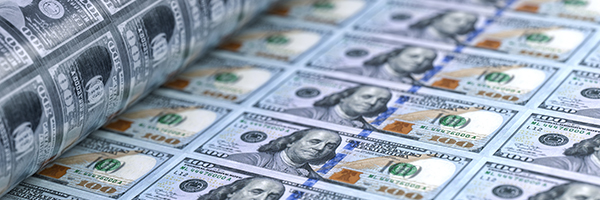All Posts

Analysts a bit more pessimistic than usual about future earnings–will the pessimism grow?
Have analysts lowered earnings estimates more than usual for companies in the Standard & Poor’s 500 for the second quarter?
FactSet says the answer is yes. During the month of April, analysts lowered EPS estimates for the second quarter by a larger margin than average. The bottom-up EPS estimate for the second quarter decreased by 2.4% (to $63.96 from $65.55) from March 31 to April 30

Domestic final sales data are clearer than GDP, but they too show a big economic slowdown
If you’re looking for a way to add clarity to the somewhat middled first quarter GDP report of last week, I’d suggest a look at a number called “domestic final sales.” Like the GDP report, domestic final sales shows a slowing economy. But without the possibly distorting effects of a big pickup in imports the growth rate remains solidly positive. But projections for domestic final sales growth for the rest of 2025 are downright dismal.

Saturday Night Quarterbacks says, For the week ahead expect…
I don’t expect the Wedneday, May 7, meeting of the Federal Reserve to produce no action on cutting interest rates, but intense scrutiny of the Fed’s words as investors search for clues on when the central bank will go into full rate-cuttinging mode.

McDonald’s, Chipotle, Starbucks all report drop in customer traffic
As economic indicators go, recent results from McDonald’s, Chipotle Mexican Grill, and Starbucks are worth paying attention to–and the message the three consumer giants are sending isn’t a positive one for the U.S. economy.

Four 25 basis point interest rates by end of 2025? Really?
In the swaps market, traders increased their wagers on four quarter-point reductions by the end of the year, with the first fully priced in for July.

Want to know why the market was up on bad GDP report?
Seems like we’re back again to a world where all the bad news is good news.

GDP falls in first quarter at 0.3% annual rate
The U.S. economy contracted at annualized rate of 0.3% in the first quarter of the year. That’s much slower growth than the positive 2.4% rate in the fourth quarter of 2024. This is the first quarterly decline in real GDP since the first quarter of 2022, and it was below expectations for a positive growth rate of 0.2%.

GM pulls its earnings guidance for 2025 even as White House announces changes to auto tariffs
Today General Motors announced that it was pulling its previous earnings guidance for 2025 and putting $4 billion in share buybacks on hold until it has more clarity on the impact of U.S. tariffs.

More signs of stress in the high-yield (aka junk) bond market
Risky corporate-debt markets–what you and I call the junk bond market–have room to drop further due to to damage from the tariff war.“We’re likely to see spreads widen from here as we see further deterioration in risk assets and in overall credit quality,” Mitch Garfin, BlackRock’s co-head of leveraged finance, told Bloomberg.

Selling my last 2 VIX Call options–but not because we’re done with volatility
Today, Monday April 28, I’m selling my last two Call Options on the VIX, the CBOE S&P 500 Volatility Index. Not because we’re done with volatility. No way. I expect lots more volatility in the weeks and months ahead. And I expect to put this trade on again. But because these two options expire on May 21

Tech stocks face high earnings hurdle
This week’s quarterly earnings reports from Microsoft (MSFT), Apple (AAPL), Meta Platforms (META) and Amazon.com (AMZN) face high earnings expectations from Wall Street analysts. Analysts expect the Magnificent Seven-—which also includes Alphabet (GOOG), Tesla (TSLA) and Nvidia (MVDA)-—to deliver an average of 15% earnings growth in 2025. That expectation has barely budged since the start of March despite the uncertainty of the Trump tariffs. The four megacaps reporting this week collectively have a nearly 20% weighting in the Standard & Poor’s 500.

Shein, online Chinese retail giant, raises U.S. health and beauty prices by 51%
Fast-fashion giant Shein Group raised U.S. prices of its health and beauty products by 51% or more. E-commerce shopping platforms like Shein and Temu face a 120% tariff on many of their products due to the U.S. government’s decision to end the “de minimis” exemption for small packages from mainland China and Hong Kong. Exporters in recent years had capitalized on the exemption, which allowed goods valued at under $800 to enter the U.S. without tariffs or customs duties. Washington will also increase the per-postal-item fee on goods entering after May 2 to $100 and even higher after June 1

Tariffs could mean some empty shelves in U.S. as early as May
President Donald Trump’s tariffs on goods from China have disrupted trans-Pacific supply chains. In the three weeks since the tariffs took effect, ocean-container bookings from China to the U.S. are down by more than 60%, Ryan Petersen, founder and CEO of Flexport, a global shipping company, told the Washington Post. Cargo carriers that bring Asian goods to the Port of Los Angeles, the nation’s main Pacific gateway, have canceled 20 port calls next month, more than three times as many as last month, according to port data. The consequence will be “empty shelves in U.S. stores in a few weeks and covid-like shortages for consumers and for firms using Chinese products as intermediate goods,” Torsten Slok, chief economist for Apollo Global Management, told the Post. “Significant” layoffs in trucking, logistics and retail are likely as soon as May, Slok said.

Saturday Night Quarterback says, For the week ahead expect…
Finally, maybe some hard data on how President Donald Trump’s tariffs are affecting the U.S. economy. At 8:30 New York time om Wednesday the Bureau of Economic Analysis is scheduled to release its first take on the GDP rate in the first quarter of 2025. Economists surveyed by the Wall Street Journal project the U.S. economic output rose at an annual rate of just 0.4% in the first quarter. That would be down from 2.4% in the last quarter of 2024 and the slowest growth since 2022. This will be the first hard data that might show the impact of President Trump’s tariff moves.

Not good: PepsiCo cuts its 2025 guidance as sales, tariffs kill the crunch
On Thursday, PepsiCo cut its full-year guidance outlook, citing a reduction in consumer spending as well as the impact of higher tariffs.
“Relative to where we were three months ago, we probably aren’t feeling as good about the consumer now,” Jamie Caulfield, PepsiCo CFO, told Wall Street analysts and investors on an earnings call Thursday morning.



